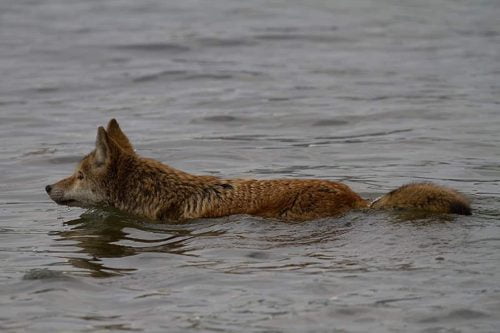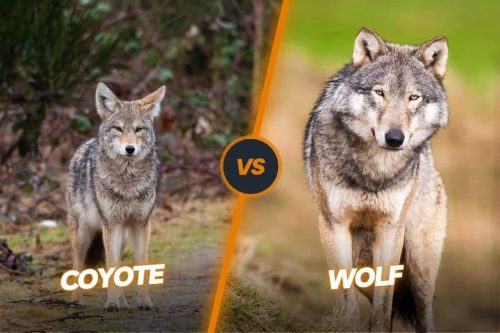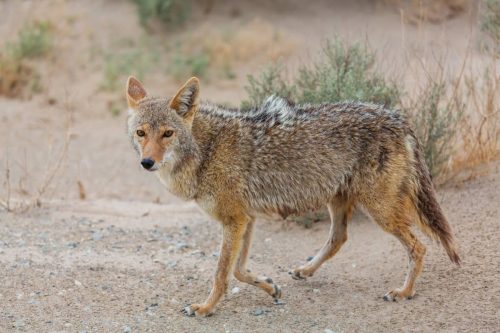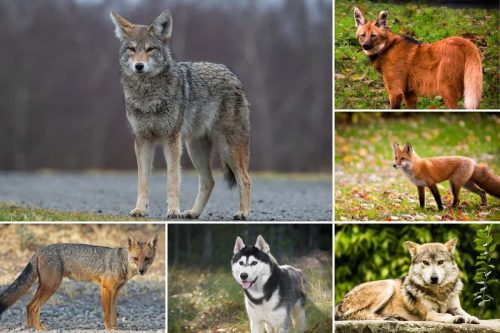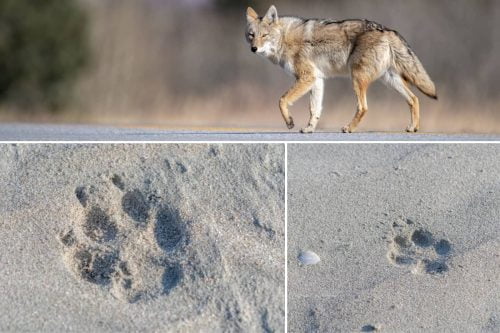Coyotes in South Dakota: Ecological Impact & Hunting Regulations
Coyotes are the native animals of South Dakota. In South Dakota, you can find a large number of coyotes along the Missouri River and black hill areas. Being a native animal of the state and also available in such a large number, the coyote had been officially declared the state animal of South Dakota in 1949. Despite being such an important animal of the state, coyotes are being targeted at various levels mainly due to their predation on livestock and Poultry.
In this article, we are going to discuss in detail the presence of coyotes in Dakota and how these wild animals are being controlled in various ways. We will also let you know the social and economic implications of the coyotes on the state of South Dakota.

Contents
- The historical presence of the coyotes in the South Dakota
- Diet and Habitat of the Coyotes in South Dakota
- Ecological Importance of the Coyotes in the South Dakota
- Rules and regulations for coyote hunting in South Dakota
- Accessible Public Areas for hunting coyotes in South Dakota
- Frequently asked questions
- Conclusion
The historical presence of the coyotes in the South Dakota
You must keep in your mind that the coyotes are native animals of the state. Prior to the 1980s, they were mainly found in the western side of the state and in the counties at the border region of the Missouri River. With the increase in the size of their population, they started expanding to the other sides of the state. Now, coyotes are available in almost all the counties of the state. They have actually expanded their range in every nook and corner of the USA.
Once it was estimated that there are almost 80 to 90,000 coyotes available in the state of South Dakota only. The population of the coyote is mainly concentrated along the drained beds of the river. Now, they are also freely roaming among human beings in the Urban and semi-urban areas of the state. Being territorial animals, they like to establish their homes in good territory. Male coyote covers at least 10 to 20 square mile in their home range while female coyote covers only 10 to 15 square mile in their home range.
Diet and Habitat of the Coyotes in South Dakota

Coyotes are the native wild animals of the state. You can mainly find them in wooded areas, along the rivers, and in areas having very tall grass or brush. Coyotes have also now shifted towards the cities of the state as they can find here plenty of food, and many places to hide. Now, you can even witness them in many big metropolitan cities like New York City, Chicago, etc.
In these cities, these animals don’t like to confront human beings and are very timid and usually run away once they encounter people. Coyotes in South Dakota rely on a variety of fruits for their diet like Birds, eggs, mice, bugs, rabbits, squirrels, garbage, pet food, bird seeds, etc. In some cities, coyotes have been highly helpful in controlling the population of rodents, squirrels, and rabbits.
Ecological Importance of the Coyotes in the South Dakota

Coyotes play a significant ecological role in South Dakota’s ecosystems. As predators and scavengers, they contribute to the balance and health of the environment in various ways:
Regulation of Prey Populations
Coyotes help regulate the populations of their prey species, which can include rodents, rabbits, and small mammals. By keeping these populations in check, coyotes prevent overgrazing of vegetation and help maintain the health of plant communities.
Cascading Effects
The presence of coyotes can lead to cascading effects throughout the ecosystem. When coyotes suppress the populations of smaller predators such as foxes and raccoons, it can reduce the predation pressure on smaller mammals and birds that they would otherwise target. This can indirectly benefit other species and even plant communities.
Carrion Disposal
Coyotes are efficient scavengers, consuming carrion. By doing so, they help recycle nutrients back into the ecosystem, which can benefit soil fertility and nutrient cycling.
Seed Dispersal
Coyotes can aid in seed dispersal by consuming fruits and then dispersing the seeds in their scat across the landscape. This can contribute to plant diversity and the distribution of plant species.
In essence, coyotes are a crucial component of South Dakota’s ecosystems, playing a role in maintaining the delicate balance of nature. Their interactions with other species and their impact on food webs contribute to the overall health and functionality of the environment. Conservation efforts often focus on maintaining healthy predator populations like coyotes as part of broader strategies for preserving biodiversity and ecological stability.
Rules and regulations for coyote hunting in South Dakota

Before engaging in hunting activities, you must know all the rules and regulations regarding hunting coyotes in the state. There is no seasonal limit for the hunting of coyotes in the state but you need to have the license before hunting. Coyote calling contests are also legally allowed in the state and bounty may also be achievable in the state.
Let’s have a look at the general rules regarding the hunting of coyotes in South Dakota.
- As you already know a licence is required, so first of all you must buy a licence for hunting.
- Electronic callers are legally allowed to use but these are expensive. You may utilize mouth and hand callers as these are cheaper but a little bit difficult to use.
- Decoys are also legal to be deployed for hunting purposes.
- In nighttime hunting, it is not allowed to utilize lights like infrared or thermal riflescopes while performing hunting.
PREDATOR/VARMINT LICENSE
In South Dakota, a “Predator/Varmint License” is a type of hunting license that allows hunters to target and harvest certain predatory and varmint species, including animals like coyotes, foxes, raccoons, skunks, and other non-game species. This license is designed to help manage populations of these species and reduce their impact on agricultural and ecological systems.
Landowners’ rules for coyote hunting in South Dakota
Landowners in South Dakota often have specific rules and considerations when it comes to coyote hunting on their property. These rules can vary depending on the landowner’s preferences, the size of the property, and the specific context. If you’re planning to hunt coyotes on private land in South Dakota, here are some important points to keep in mind:
- Always obtain proper permission from the landowner before hunting coyotes on their property. This is a sign of respect for private property rights.
- Follow any designated access points or routes provided by the landowner.
- Landowners might have specific rules or guidelines regarding restrictions on hunting methods like areas where hunting is allowed, and any other considerations. Make sure you’re aware of and follow these rules.
- Maintain open communication with the landowner. This can help foster a positive relationship and ensure everyone is on the same page.
- Prioritize safety at all times. Be aware of your surroundings and the presence of other individuals or structures on the property. Always follow safe firearm handling practices.
- Avoid excessive disturbance to the land, wildlife, and other people.
- Some landowners might request information about your hunting activities, such as the number of coyotes harvested.
- Pack out any trash or waste and leave the land as you found it. Minimize your impact on the environment.
Read for details about coyotes in Illinois state.
Accessible Public Areas for hunting coyotes in South Dakota

South Dakota offers a variety of accessible public hunting areas where you can hunt coyotes and perform other games. These areas are managed by the South Dakota Game, Fish and Parks (GFP) and provide opportunities for both residents and non-residents to enjoy hunting. Keep in mind that access and regulations can vary depending on the specific public hunting area. Here are some popular types of public hunting areas you might consider:
State Game Production Areas
State GPAs are publicly owned lands managed by the GFP for wildlife habitat and recreational use. These areas provide opportunities for various types of hunting, including coyote hunting. Be sure to check specific GPA regulations and maps for hunting opportunities and access points.
Walk-In Areas
South Dakota offers Walk-In Areas, which are private lands where landowners have enrolled their property for public hunting access. These areas provide additional hunting opportunities for both residents and non-residents.
National Forests and Grasslands
Some national forests and grasslands within South Dakota might allow hunting, including coyote hunting.
Wildlife Management Areas
WMAs are publicly owned lands managed by the GFP for wildlife conservation and recreational use. These areas might provide opportunities for coyote hunting, but regulations can vary between different WMAs.
Frequently asked questions
Conclusion
The presence of coyotes in South Dakota reveals the intricate beauty of nature’s adaptability. These intelligent predators, known for their remarkable versatility, have seamlessly woven themselves into the fabric of the state’s diverse landscapes. From the sprawling prairies to the enchanting forests of the Black Hills, coyotes inhabit a multitude of habitats.
Their role as both predators and scavengers underscores their significance in maintaining ecological balance. By preying on small mammals and helping control rodent populations, coyotes contribute to the health of ecosystems and the sustainability of agriculture. The regulations, licenses, and hunting opportunities offered by the South Dakota Game, Fish and Parks reflect a commitment to maintaining healthy ecosystems while ensuring responsible and ethical hunting practices.

Izzy is an experienced ranch worker who has a passion for exploring nature and getting up close to wildlife. With her connections to various animal organizations, Izzy is well-versed in animal care and rehabilitation.

